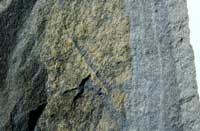 |
| The photo above shows 25mm long graptolite from the Manx Group. Image is reproduced here by kind permission of Manx National Heritage. |
Graptolites are now extinct but during the Lower Palaeozoic era (around 550-300 million years ago) they lived as free-floating colonies resembling thin twigs or wishbones. They probably floated near the surface of the Iapetus Ocean and when they died they sank to the sea bed where some were buried and preserved as fossils. These fossils often appear as flattened grey strips around 3-5 cm long and a few millimeters wide with saw-tooth serrations along one long edge. Unfortunately, they can be extremely difficult to spot and relatively few have been found on the Island. However, the subtle variations in their shapes due to the effects of evolution have been crucial in telling us that the Manx Group was formed around 470 million years ago while the Dalby Group was deposited around 425 million years ago.
In the absence of more graptolites to help us work out the ages of the different parts of the Manx Group, we have to rely on acritarchs. These are fossilized planktonic algae and look like pollen grains, but being typically around 0.025 mm in diameter, they require the use of a high powered microscope after dissolving most of the rock with acid.